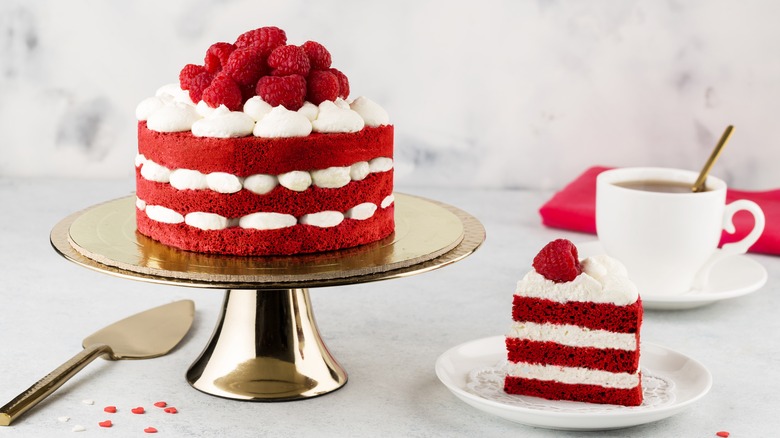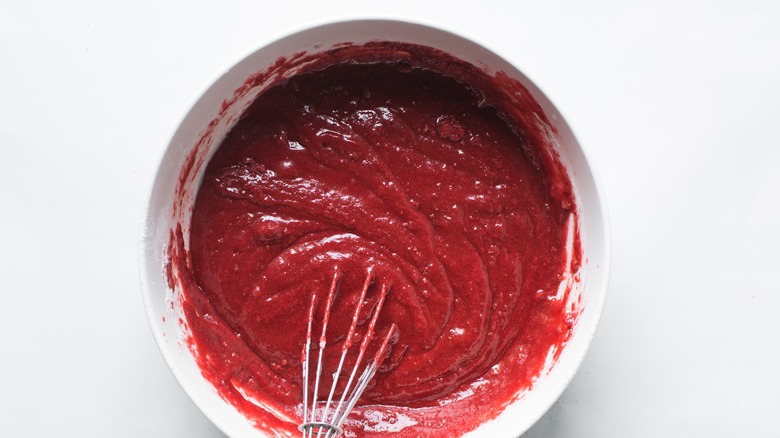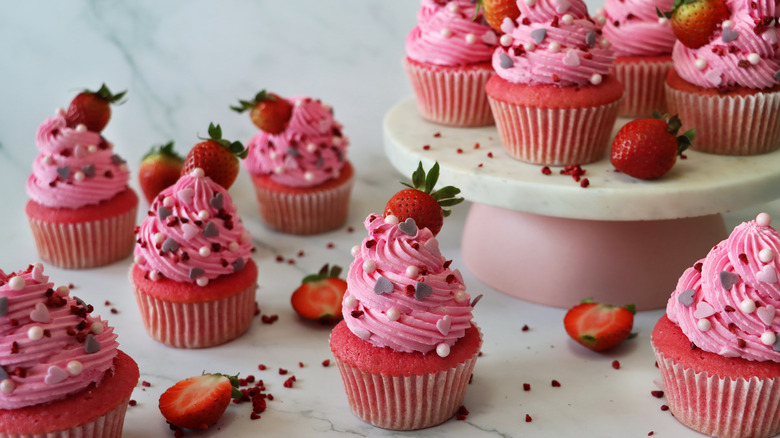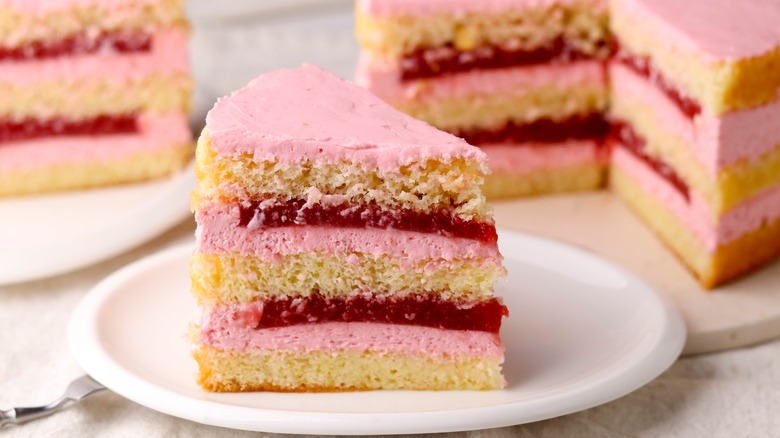What Makes Red And Pink Velvet Cake Different?
While the red color doesn't exactly add flavor to the cocoa-infused red velvet cake, the vibrant hue somehow makes the eating experience more pleasurable. If you enjoy eating with your eyes, red velvet has a lesser-known, more delicate cousin: Pink velvet cake. Both typically get their color from a red or pink food coloring, or a more natural dye like beet juice or strawberry, but the pretty pink cake gets less of the coloring than the deep red version.
Besides the different shades, there is one key ingredient that differentiates red velvet from pink, which is cocoa powder. Red velvet typically doesn't have a deep chocolatey or rich fudge flavor, but it is always lightly flavored with cocoa. Pink velvet cake recipes do not contain cocoa, as this would darken the soft color. However, both color varieties do contain vanilla extract for flavoring. Both cakes also have a subtle tangy flavor from the addition of buttermilk.
Don't forget about the frosting — the perfect velvet cake, whether pink or red, requires a cream cheese frosting. The dense, tangy icing brings flavor to the lightly flavored velvet cakes. Vanilla buttercream frosting, which is rich, buttery, and quite sweet, also works here; to tone down the sweetness, try ermine frosting which has less sugar, but is still rich and creamy, and was the original frosting for red velvet cake.
What is a velvet cake?
Both cakes are referred to as "velvet" — but why? The name of the cake actually has a history that dates back to the Victorian Era. During this time period, many cakes were very dense and used a coarser flour than what we typically use today. The addition of acidic ingredients, like vinegar, buttermilk, and even cocoa powder, leads to a reaction with the baking soda and softens the flour, resulting in a fluffier, lighter cake with a delicate, almost "velvety" texture.
Pink and red are not the only color options for a velvet cake, though — there are endless hues you can use for this dessert as long as the base recipe for a soft, moist cake is followed. Black, orange, blue, or rainbow velvet cake are all possible with the right food coloring and flavorings. Velvet cakes that place a lesser emphasis on color compared to additional flavors, such as spices or lime, are also an option.
How red velvet got its coloring
Now that you know that velvet cakes have origins in the Victorian Era, it's time to dive into how the eye-catching red interior of red velvet cakes came to be. After all, they weren't always so red — when velvet cakes emerged, cocoa was a typical ingredient to add to these luxurious desserts, as is done today. However, it was discovered that when cocoa and an acidic ingredient was combined, typically vinegar during this time period, it gave the cake a deep reddish brown color.
Red velvet cake is popular in the South, where, in more recent times, a classic Southern ingredient became common in recipes as the acidic component: buttermilk. The chemical reaction between buttermilk and baking soda, plus the cocoa, resulted in a more vibrant red color. Plus, the addition of the creamy, tangy buttermilk is key for creating moisture in the cake, which is why Ina Garten uses the ingredient when baking red velvet cupcakes.
As the cake caught on, it inspired a little extra help in the coloring department. In the 1940s, a company called Adams Extract decided to capitalize on the cake's popularity by selling red velvet cake kits, which included a bottle of its red food dye. Today, the bold reddish hue of red velvet cake is sometimes caused by a natural chemical reaction, but also typically the addition of an artificial or natural coloring to amp up the color further.
It's unclear where exactly pink velvet cake came from
The origins of pink velvet are not known — however, it is clear that the lightly dyed cake was inspired by its red counterpart. There is no traceable history, like red velvet, and not a specific bakery, person, or location tied to the pink version. A quick Google search shows hundreds of recipes for pink velvet cake, cupcakes, and cookies, so it's not exactly an under-the-radar cake flavor. For instance, Crumbl Cookies offers a pink velvet cake cookie, while Dunkin' Donuts lists a pink velvet macchiato on its menu, signaling that it has indeed been established as a popular cake flavor.
When examining pink velvet and red velvet cake recipes closer, there isn't a difference in terms of sugar, flour, egg, oil, or even buttermilk. The only difference truly is the color and lack of cocoa. Typically, the frosting is left uncolored for both versions of the dessert, but sometimes pink velvet gets a pink frosting to match its colored base.
Choosing between red and pink velvet cake
Red velvet cake is undeniably more well known than the pink variety; it's easy to go to a bakery or grocery store and find red velvet cupcakes, layered cakes, and even cookies. But pink velvet — not so much. It seems that this color is more common amongst home bakers and as a specialty flavor for food chains. Each flavor and color can be used interchangeably to make a traditional velvet cake, bundt cake, cupcakes, cookies, or other baking creations.
If you prefer a richer flavor, red velvet may be the better choice. This cake gets both cocoa and vanilla flavoring, so it has a bit more depth than pink velvet, which only has vanilla. Otherwise, choosing between the two cakes is somewhat of a simple color preference.
If you want to amplify the existing flavors, red and pink velvet should be treated differently. Playing around with delicate flavors, some pink velvet can be elevated with citrus, with a lemon extract or lemon zest. Almond extract would also pair well with the vanilla, while the addition of rose water would help match the color with the flavor. Red velvet could take on the addition of more chocolate, either in the form of more cocoa powder or chocolate chips in the batter. If you're baking a layered cake, the center layer could be replaced with chocolate ganache. Both versions of velvet cake would take well to the addition of red fruits, like strawberry, raspberry, or cherry.




